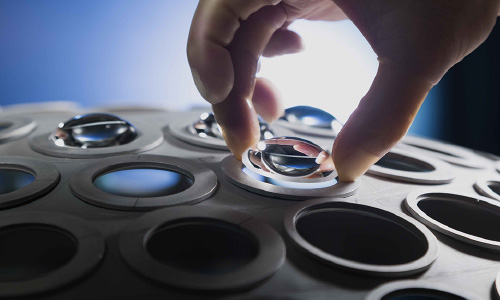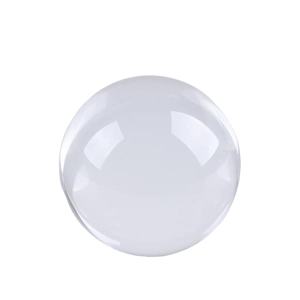
Ball lens is an important optical element, which is mainly made of optical glass and other materials. It is used for the coupling between optical fibers, between laser and optical fiber and between optical fiber and detector, or for the collimation of optical fiber beam in thin film filtered dense wavelength division multiplexer.
Ball lens is also called glass bead. It is a solid or hollow glass bead with a diameter of several microns to tens of microns. Its application fields include chemical industry, military industry, aerospace, transportation, petroleum, light industry, medical treatment and other departments. It has the characteristics of good surface finish, good light reflection, directional reflection, high impact strength, chemical stability, light bulk weight and so on.
Introduction to Ball lens
Ball lens is an important optical element, which is mainly made of optical glass and other materials. It is used for the coupling between optical fibers, between laser and optical fiber and between optical fiber and detector, or for the collimation of optical fiber beam in thin film filter dense wavelength division multiplexer. It plays an important role in the optical system. Spherical lens is also called glass bead. It is a solid or hollow glass bead with a diameter of several microns to tens of microns. Its production began in the United States before World War II. Later, European countries also began industrial production one after another. The varieties and specifications are increasing day by day, and the application fields involve various departments such as chemical industry, military industry, aerospace, transportation, petroleum, light industry, medical treatment and so on.
There are two kinds of manufacturing methods of ball lens: one is to heat the glass powder to the molten state through high-temperature gas and form circular beads by surface tension, including powder method and calcination method; Or melt the glass batch and directly spray it with high-speed air flow, and the glass droplets form beads due to surface tension. Glass beads have the characteristics of good surface finish, good light reflection, directional reflection, high impact strength, chemical stability, light bulk weight and so on.
Ball lens has a wide range of uses, which can be roughly divided into two categories: ① making use of the nature of the reflected light energy of the spherical lens to reflect back to the direction of the incident light source, making traffic signs, mixing paint for road marking, or making reflection or photographic screens, etc. ② Using its spherical shape, glass hardness, chemical stability and light bulk weight, it is used for grinding medium of metal workpiece, shot peening and cleaning treatment, and filling material of plastic products. Hollow glass beads have the advantages of light weight, high strength and low thermal conductivity. They can be used as light thermal insulation materials in aerospace technology, marine materials and chemical equipment.
Theoretical analysis of ball lens
At present, the surface research of ball lens at home and abroad is mainly in two aspects. First, optical design software (such as code V and ZEMAX) is used to design the spherical lens, so as to solve the problems of light transmission and imaging in the spherical lens; One is to study the preparation process of spherical lens. Fig. 1 shows a schematic diagram for calculating the surface characteristics of spherical and non spherical lenses, in which the dotted line area is a non spherical lens and the solid line circular area is a spherical lens. Points P and s are the points on the surface of non spherical lens and spherical lens respectively, and Z and Z ‘are the corresponding transverse coordinate points.
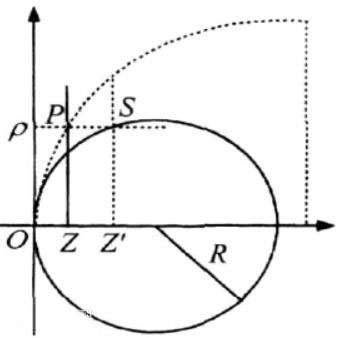
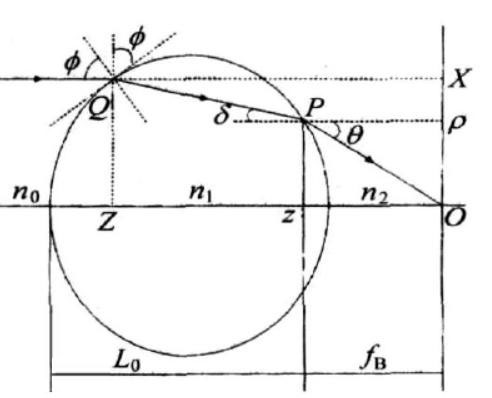
Figure 2 shows the analysis diagram of ball lens. After twice refraction through a spherical lens, the light is finally focused to point o. Where point Q and point P are the two points on the spherical lens, that is, the two points of light refraction, and the length of PQ is set as L. Suppose that the refractive index of the spherical lens is N1, and the refractive indexes of the medium on the left and right of the lens are N0 and N2 respectively. The incident angle of light is φ, After the first and second refraction, the refraction angles are δ and θ。 According to Snell’s law, we can get the equations at point P and point Q respectively:
n1sin δ= n2sin θ
n0sin = n1sin(- δ)
In the cylindrical coordinate system, the coordinates of point Q and point P can be expressed as Q (x, z) and P( ρ, z) , the coordinates of the Q point on the first surface of the spherical lens can also be shown in the table
As follows:
X( θ)= fBtan θ+ Lsin δ ( θ)
Z( θ)= fB+ Lcos δ ( θ)
The coordinates of point P on the second surface of the spherical lens can also be expressed in the following functional form:
ρ ( θ)= fBtan θ
z( θ)= fB
Taking K9 glass as an example, the refractive index is N1 = 1.5163, and assuming that the medium on both sides of the spherical lens is air, the refractive index is N0 = N2 = 1, the diameter of the spherical lens is 1.60cm, and the maximum refractive angle is θ= 45°。
Ball dielectric lens reflector
Ball dielectric lens reflector is a new type of passive radar echo intensifier. It has the advantages of low cost, high reliability, small volume, light weight and good wide-angle response. It has unique advantages over active radar echo intensifier and other passive radar echo intensifiers. At present, this kind of spherical dielectric lens reflector has entered the practical stage abroad. Japan’s Tokyo Jiji Co., Ltd., the British air refueling company and the American EMSON Cumming company have all produced products of various specifications. 1 false targets used as echo intensifiers electronic countermeasures on aircraft missiles targets; It is used as navigation aids in waterways, ports and airports; It is used in fishing boats and lifeboats to improve the radar’s search ability and range calibration accuracy; Use it as a warning sign around marine animal and plant farms, offshore exploration and military test areas; It can also be used for camouflage facilities of tanks, artillery vehicles and bridges.
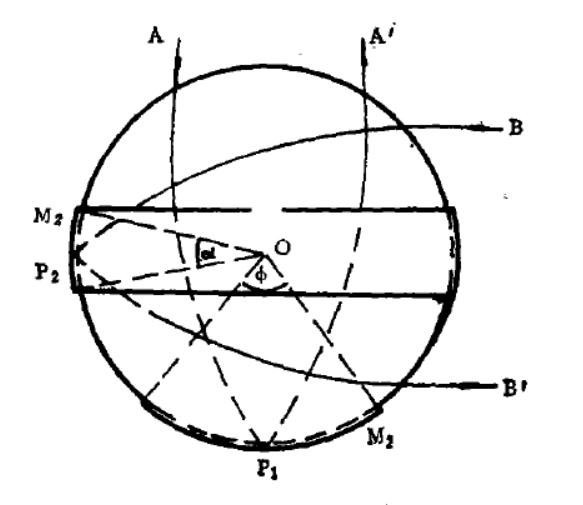
The ball dielectric lens reflector is composed of a spherical Luneberg lens and a metal reflector. Lomber lens is a kind of lens whose refractive index changes continuously. It has two focal points, one on the sphere and the other at infinity. In this way, it can turn a point source on the sphere into a plane wave through the lens. In turn, it can focus a plane wave passing through the center of the sphere to a point on the sphere through the lens. The metal reflector covers a part of the spherical surface. Fig. 3 is a schematic diagram of the working principle of the spherical dielectric lens reflector. When a plane wave is incident along the horizontal direction, due to the focusing effect of the Lomber lens, the electromagnetic wave will gather on the spherical PZ point, and the PZ point is on the metal reflecting surface MZ, which will cause reflection. The electromagnetic wave passes through the lens again, and according to the principle of the Lomber lens, it will become a plane wave with the propagation direction opposite to the human shooting direction. Because the lens is spherically symmetrical, the metal reflecting surface MZ surrounds the equatorial plane of the ball for one week (360), Therefore, the reflection characteristics of electromagnetic waves are omni-directional. This is the N-lens reflector. As shown in Figure 3, when the electromagnetic wave is emitted from the person above the lens, it will also pass through the lens and focus on the spherical point P, which is reflected by the metal reflecting surface M: to form the ability of upward reflection. According to the size of the metal reflecting surface M, the spatial reflection capacity of the three-dimensional cone angle can be determined. This is the type I lens reflector, which has the ability of directional reflection. Type 111 spherical dielectric lens reflector has two metal reflecting surfaces, namely Z and Z. it has reflection ability in both headspace and horizontal directions.
End

